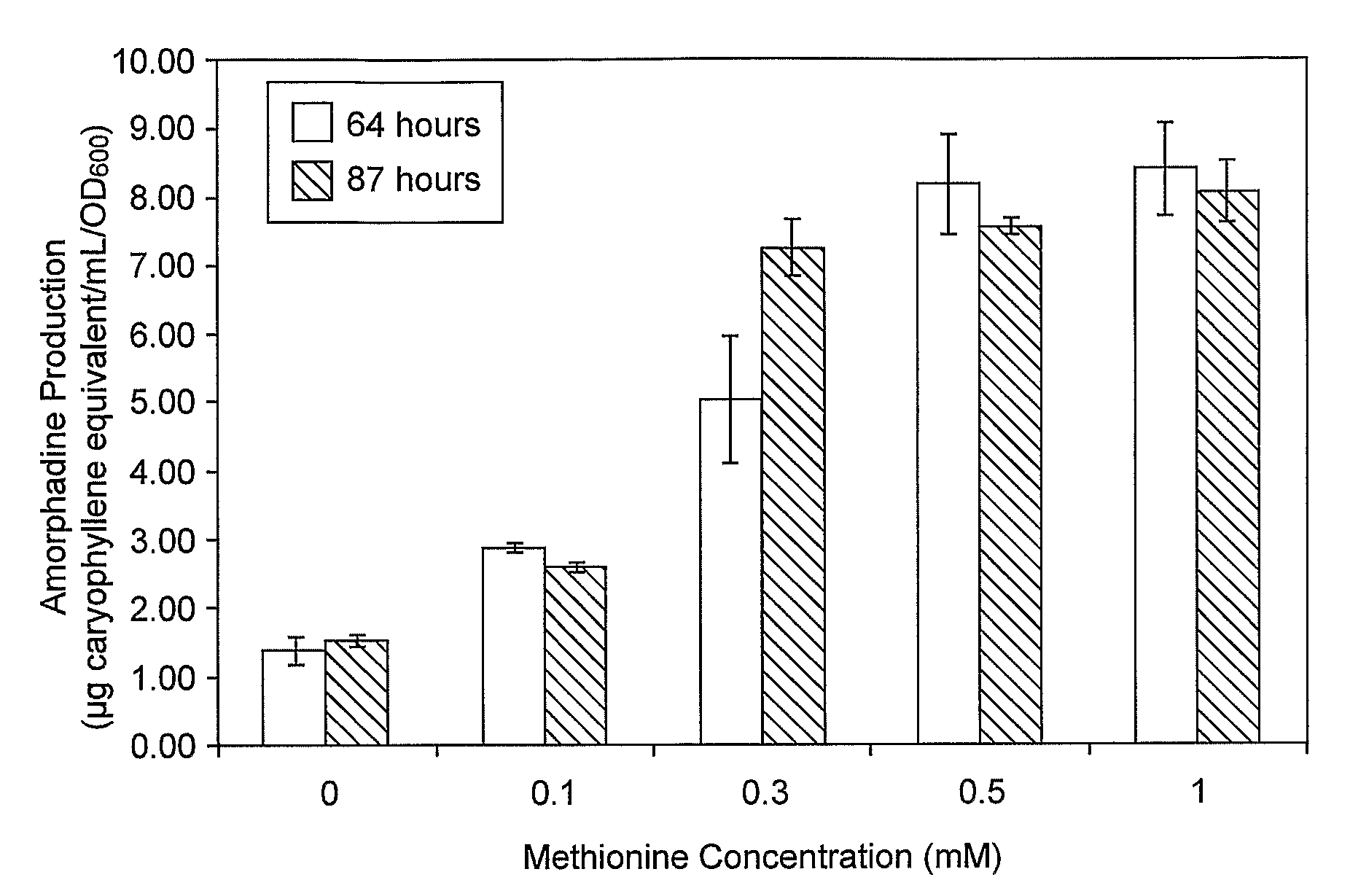Genetically modified host cells and use of same for producing isoprenoid compounds
a technology of host cells and isoprenoids, which is applied in the field of isoprenoids, can solve the problems of low yield, high cost, and inability to economically or economically synthesize, and achieve the effects of increasing the activity of prenyl transferase, and increasing the activity of one or more mevalonate pathway enzymes
- Summary
- Abstract
- Description
- Claims
- Application Information
AI Technical Summary
Benefits of technology
Problems solved by technology
Method used
Image
Examples
example 1
Producing High Levels of an Isoprenoid Compound in a Genetically Modified Yeast Cell
Materials and Methods
[0153]Chemicals. Dodecane and caryophyllene were purchased from Sigma-Aldrich (St. Louis, Mo.). 5-fluoortic acid (5-FOA) was purchased from Zymo Research (Orange, Calif.). Complete Supplement Mixtures for formulation of Synthetic Defined media were purchased from Qbiogene (Irvine, Calif.). All other media components were purchased from either Sigma-Aldrich or Becton, Dickinson (Franklin Lakes, N.J.).
[0154]Strains and media. Escherichia coli strains DH10B and DH5α were used for bacterial transformation and plasmid amplification in the construction of the expression plasmids used in this study. The strains were cultivated at 37° C. in Luria-Bertani medium with 100 mg liter−1 ampicillin with the exception of pδ-UB based plasmids which were cultivated with 50 mg liter−1 ampicillin.
[0155]Saccharomyces cerevisiae strain BY4742 (Baker Brachmann et al. (1998) Yeast 14(2):115-132), a deri...
example 2
Yeast Cells Genetically Modified to Produce Higher Levels of Acetyl-CoA
[0187]A multicopy plasmid, pRS426ALD6 was constructed, which carries the ALD6 gene encoding acetaldehyde dehydrogenase. Plasmid constructs are shown schematically in FIG. 9. When pRS426ALD6 was introduced into control Saccharomyces cerevisiae strain EPY213 (MATα lys2 ura3 erg9::pMET-ERG9 pRS425 ADS integrated tHMGR, upc2-1), cell growth and amorphadiene production level decreased, as shown in FIGS. 10a and 10b. Overexpression of the ALD6 gene increased the level of acetaldehyde dehydrogenase (ALD) activity about 20 times higher than that of the control strain, and led to an accumulation of acetate at about 1 g / L (16 mM) in the medium, as shown in FIG. 10c. Overproduction of ALD resulted in a reduction in the carbon flux through alcohol fermentation and an increase in the carbon flux through the pyruvate dehydrogenase bypass that leads to the mevalonate pathway.
[0188]The multicopy plasmid pRS426ACS1 (as depicted i...
example 3
Producing High Levels of an Isoprenoid Compound in a Genetically Modified Yeast Cell
[0191]Plasmid pRS425-Leu2d was constructed by deleting the promoter starting from 29 base pairs before the ATG start codon from the LEU2 gene on pRS425ADS to create the leu2-d allele. A 2 micron plasmid containing leu2-d as the selection marker has been previously found to increase copy number and stability of the plasmid. Plasmid pRS425-Leu2d is depicted schematically in FIG. 21.
[0192]S. cerevisiae strain EPY224 was cured of plasmid pRS425ADS and transformed with the newly constructed pRS425ADS-Leu2d.
[0193]Each of these strains (EPY224 containing pRS425ADS; and EPY224 containing pRS425ADS-Leu2d) was grown overnight in a culture tube containing 10 mL of synthetically defined medium (dropped out for leucine, histidine, and methionine) containing 2% glucose. Six 50 mL cultures were inoculated from each of the overnight cultures. Three contained synthetically defined (SD) medium lacking leucine, supplem...
PUM
| Property | Measurement | Unit |
|---|---|---|
| temperature | aaaaa | aaaaa |
| temperature | aaaaa | aaaaa |
| temperature | aaaaa | aaaaa |
Abstract
Description
Claims
Application Information
 Login to View More
Login to View More - R&D
- Intellectual Property
- Life Sciences
- Materials
- Tech Scout
- Unparalleled Data Quality
- Higher Quality Content
- 60% Fewer Hallucinations
Browse by: Latest US Patents, China's latest patents, Technical Efficacy Thesaurus, Application Domain, Technology Topic, Popular Technical Reports.
© 2025 PatSnap. All rights reserved.Legal|Privacy policy|Modern Slavery Act Transparency Statement|Sitemap|About US| Contact US: help@patsnap.com



